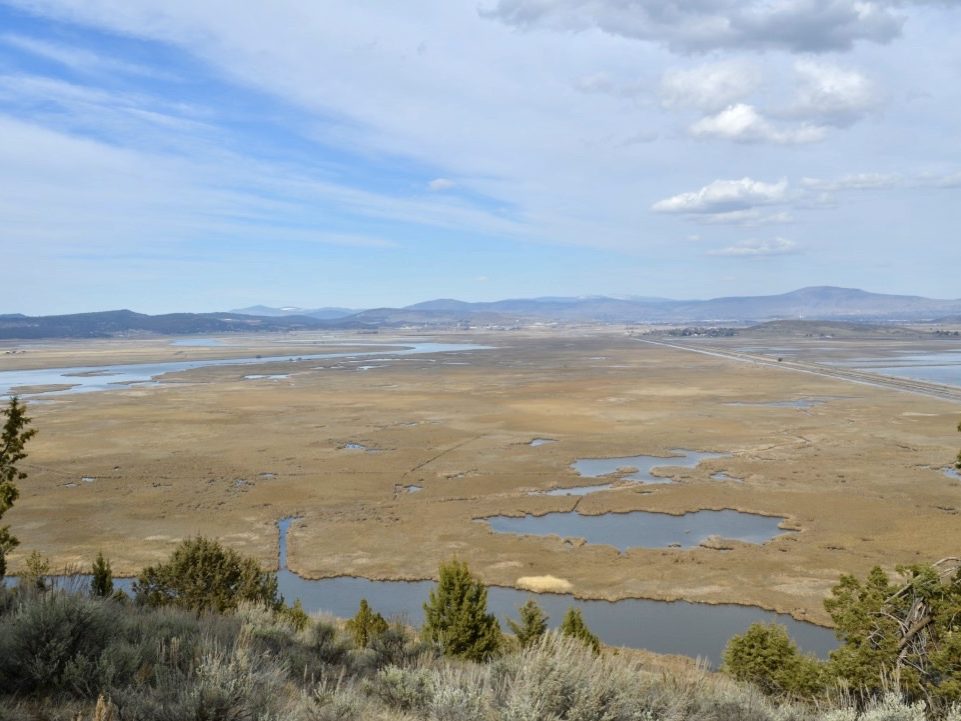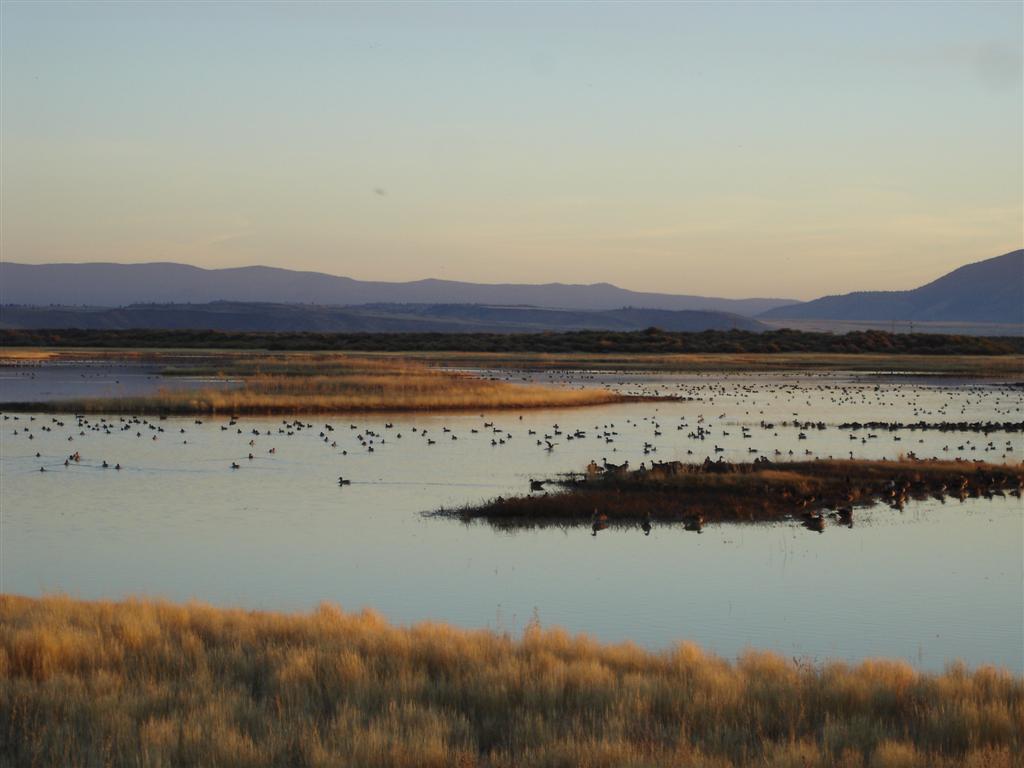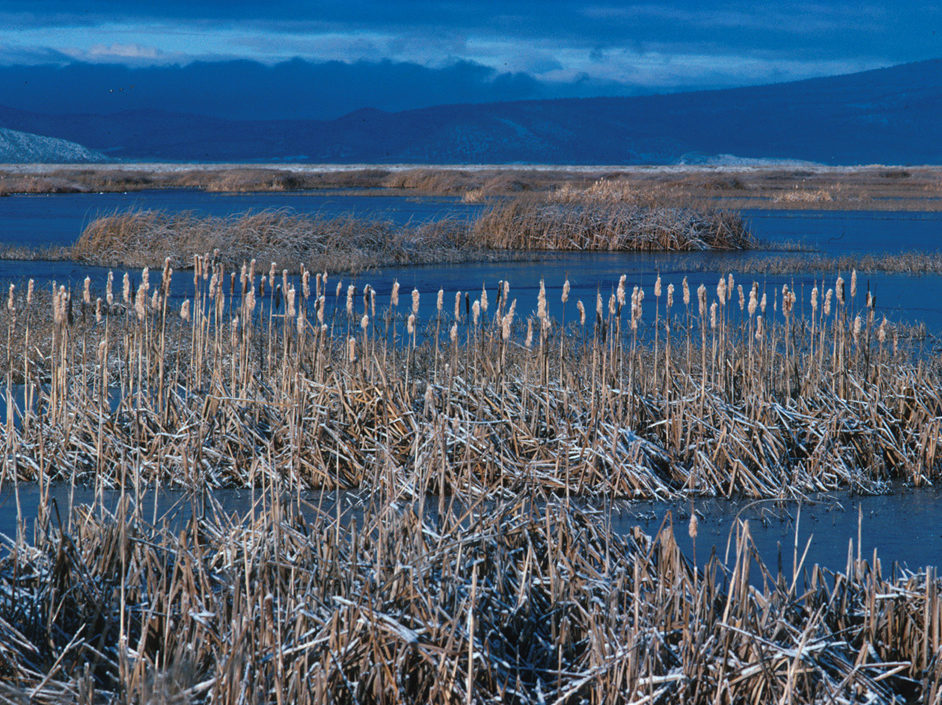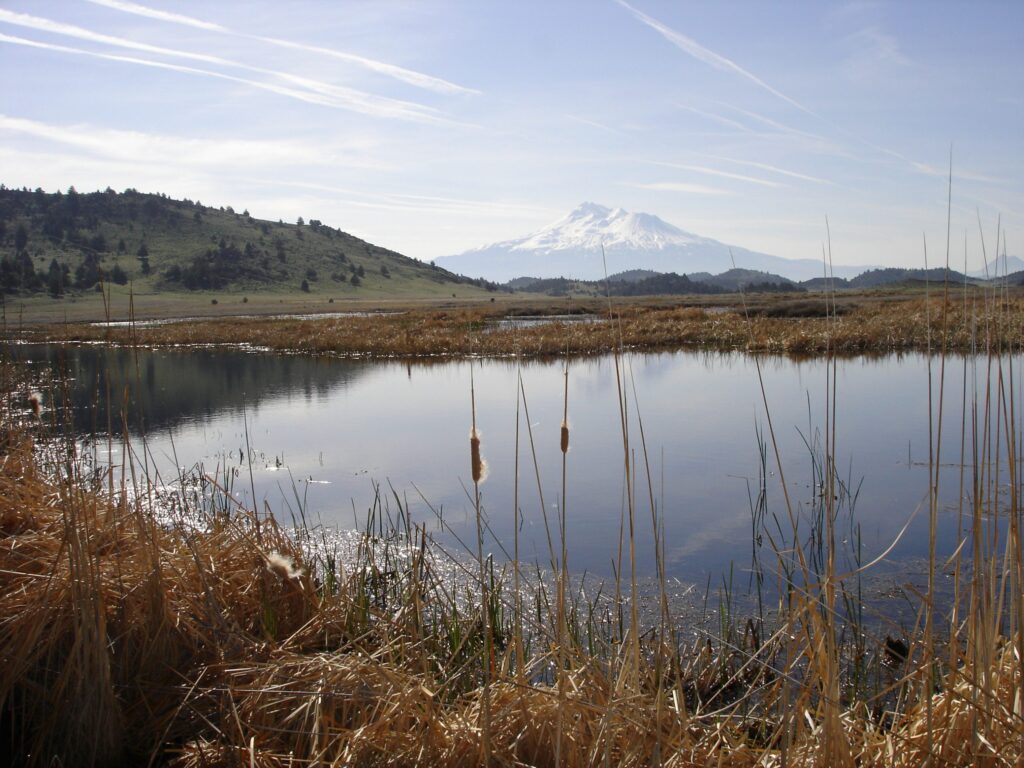From the top of Wild Horse Butte in southeastern Oregon, the Klamath River snakes through tule bulrush and cattails on Furber Marsh to the north. In the opposite direction, Lower Klamath National Wildlife Refuge (NWR) stretches out to the mountains on the southern horizon, its flooded parcels glinting in the afternoon sunlight. This vantage makes it easy to imagine the Klamath Basin’s massive value to migratory birds, including about 80 percent of the Pacific Flyway’s wetland-dependent birds that use the Basin and surrounding agricultural landscapes each year.
Around the base of the butte is Jason Flowers family’s farm. In early March, he’s gearing up for the growing season, but not all of the fields on his property are going to be used this season. In fact, one of the fields is covered in water, and has been each spring for the last few years. Northern pintails cover the de-facto wetland, constantly moving, heads bobbing as they forage on seeds and aquatic invertebrates, occasionally picking up in small flocks and then settling back into the agricultural marsh.
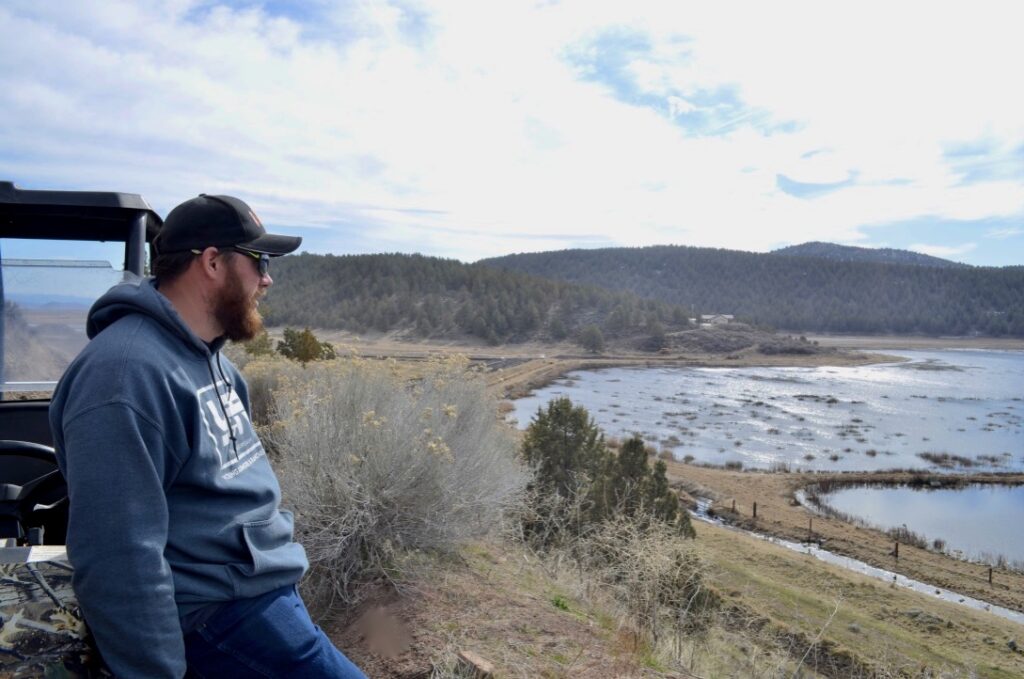
Flowers is one of several local agricultural producers that participate in the U.S. Fish and Wildlife Service’s Walking Wetlands program. In exchange for high-quality, organic farmland on Lower Klamath NWR, he maintains the same number of acres on his own property as wetland habitat for the migratory waterfowl that depend on the Klamath Basin’s wetland habitat and abundant agricultural resources each year.
“Being able to trade helps the bottom line,” Flowers said. “The refuge land is essential for doing this program.”
The Klamath Basin’s enormous historic value to Pacific Flyway waterfowl, shorebirds, and waterbirds is at risk due to declining water availability for Lower Klamath NWR and associated agricultural lands – like Flowers’ farm. The resulting habitat loss represents the first strand in the unraveling of a connected complex of habitats that have sustained birds for eons during the migration, breeding and wintering periods of their life cycle, and, if not addressed, could have a cascading effect on Pacific Flyway waterfowl populations.
“There have to be wetlands in this landscape to keep it productive.”
John Vradenburg
Dustin Taylor, the integrated pest management specialist for the refuge complex in the Klamath Basin, manages the cooperative farming programs on Lower Klamath and Tule Lake NWRs. He works with farmers and private landowners to manage flood-fallow wetlands and the flooding of un-harvested grain for the benefit of migratory waterbirds through the Walking Wetlands program. Taylor said that the program represents a system that intricately links both natural and human processes.
“The relationship between the refuges and the farming community are valuable,” Taylor said. “Both the refuges and the farmers in the basin are tied at the hip. If conditions get hard, it’s hard for both.”
As a fourth-generation farmer in the basin, Flowers is well aware of the duality of basin farmland as wildlife habitat. In fact, his dad was the one who started flooding that field, 30 years before Walking Wetlands even started.
“When they started farming, they found that if they flooded it every other year, their production was better,” he said. “Dad always enjoyed doing it because he liked having the birds around.”
Farming works on the refuge, according to refuge biologist John Vradenburg, because of the fertility of wetland ecosystems. The Klamath Basin’s historical wetland habitats are one reason farming has been so successful in the area to date, and now these refuge programs continue that soil fertility process.
“These soils are productive because they were wetlands,” Vradenburg said. “Wetlands are the keystone ecosystem in the Klamath Basin. They provide numerous ecosystem services, and specifically in the Basin they benefit water quality and support fish, wildlife, and people, especially agricultural producers. Without wetlands, the whole system starts to fall apart.”
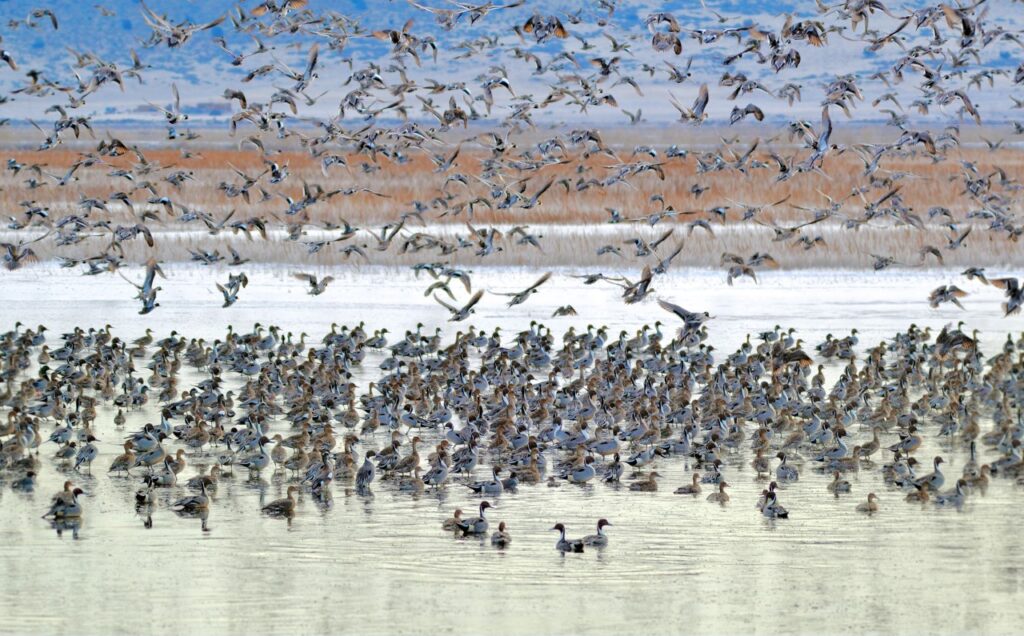
In addition to the Walking Wetlands program, Lower Klamath and Tule Lake NWRs run cooperative farming programs. Both the Walking Wetlands and the cooperative farming are enabled as a result of the 1964 Kuchel Act, which mandates that land on Lower Klamath, Tule Lake, Upper Klamath, and Clear Lake NWRs are managed for both wildlife and agriculture. The cooperative farming program uses a competitive bid process. In lieu of payment for farming on the refuge, participants in the co-op program must leave a certain percentage of grain behind after they harvest in the fall (typically 25-33 percent). In some circumstances, farmers will provide off-refuge flood-fallow wetlands or fall-flooded unharvested grain as well, the amount of which changes yearly depending on agricultural markets.
Thad “Bronc” Johnson is one of those farmers. He received his first co-op plot in 2010, his first year out of high school, and has had one most years since. Driving around the refuge, he’s able to point out the plots on which he’s raised grain in the years since and list their various merits, whether it’s the better soil on the California side of Lower Klamath or the remoteness of the far reaches of the refuge. Last fall, he said, he startled a cow elk and her calf in one of his fields on the refuge.
“I actually enjoy it out here,” he said. “We get to see something different down here everyday.”
Without the cooperative farming program, Johnson wouldn’t be able to participate in the organic farming taking place on the refuge. He doesn’t own croplands despite being a fifth-generation farmer in the Basin. He’s young, and just starting out. Organic grains have a two-to-one mark-up, and Johnson, who grows primarily barley and wheat, is able to continue farming as a result. Plus, he said, he likes that it’s good for the refuge – and the birds.
“We try hard for these guys,” he said. “It’s a privilege to farm down here.”
Vradenburg can confirm the agricultural benefits to bird populations that use the refuge. Not only does flood irrigation provide shallow wetland habitat for ducks, geese, cranes, herons, and others, but birds of prey like bald eagles and hawks thrive on rodents flushed out of fields by flooding. Flooding is also a tried-and-true method of getting rid of invasive species like quackgrass. And, of course, there’s the grain left behind for the birds swinging through the area during fall migrations.
“When we get these guys rotating their crops through here, it increases our productivity for the birds,” he said.

Farming works on the refuge, according to Vradenburg, because of the fertility of wetland ecosystems. Using flooding to pre-irrigate grain fields and rotating fields between crop production and wetland communities is a huge component of the collaboration. Continuing these refuge programs depends on a fragile symbiosis between farming and wetland habitats.
“Ecologically, you have to have this process happening to keep these lands productive,” Vradenburg said. “There have to be wetlands in this landscape to keep it productive.”
An uncertain water future is the main threat to this symbiosis. Low winter snowpack in the Cascades and a spring with no rain means drought is on the horizon; in addition, water supplies for farms and the refuges have again been reduced to meet new requirements for Coho salmon in the Klamath River. In early May, the Klamath Project announced further reductions in the amount of available irrigation water for the 2020 season, which could mean the flows are shut off before summer even reaches its peak. This combination has both farmers and refuge staff scrambling to prepare for a season with no water. Many of the once-year-round wetlands are already seasonal, and Taylor said drought will further impact the ability of both landowners and the refuges to operate, let alone to provide wetland habitat.
“Our ability to provide agricultural habitat to waterbirds and farming opportunities for the community is affected as well,” he said.
And that, according to Vradenburg, threatens the entire community. When everyone depends on water to grow crops, including the birds – and the system is stretched beyond its capacity to support the demand – drought is less of a seasonal inconvenience and more of an existential threat.
“It is one of the last places where you get a sense that these are family farms and family operations,” he said. “It’s the fabric of what this place is.”
